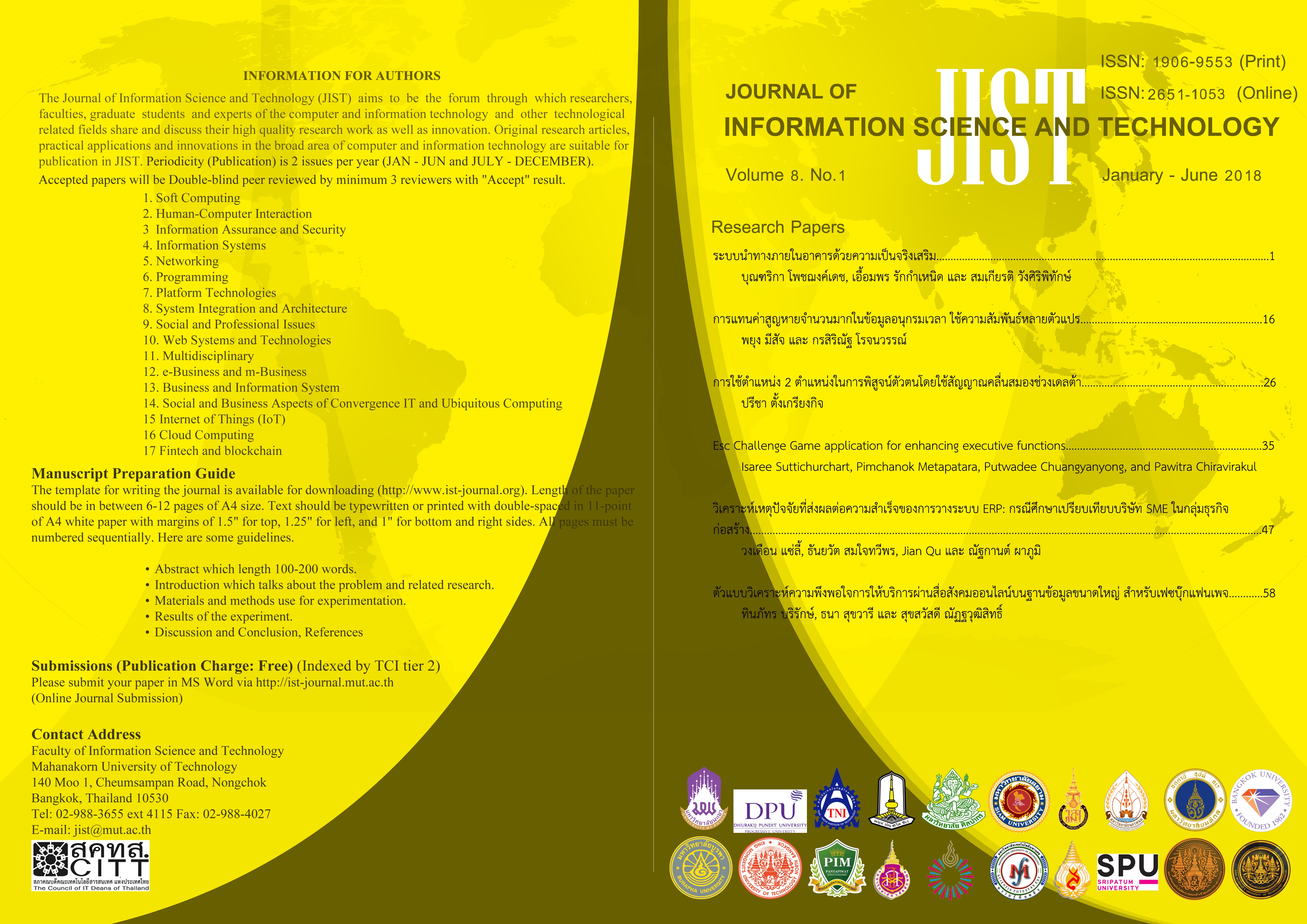The Imputation Many Missing Value in Time Series Data Use Multivariate Relationships
Main Article Content
Abstract
- Time series information is important in many tasks. This is useful for predicting trends in business judgment. The problem of data collection is losing many potential data in the field. This make data analyzing cannot be performed efficiently. This paper proposes how to fill in the missing time value in the time series data. Many use multi -variable relationships by using existing data, create a fill missing value. The research focused on finding the right data model for teaching the missing value model by comparison of four alternative techniques: Row Average, K-Nearest Neighbor(KNN), Fuzzy Logic Systems and Artificial Neural Network .The research found Artificial Neural Network technique provides predictive effect a nd when used to replace lost values, the results are similar. T hat using some of the available data from multiple variables. It can be used to create a lossless representation. Variable data many variables will directly affect the formatting of data and models. Good data before creating a replacement for lost values.
Article Details
This work is licensed under a Creative Commons Attribution-NonCommercial-NoDerivatives 4.0 International License.
I/we certify that I/we have participated sufficiently in the intellectual content, conception and design of this work or the analysis and interpretation of the data (when applicable), as well as the writing of the manuscript, to take public responsibility for it and have agreed to have my/our name listed as a contributor. I/we believe the manuscript represents valid work. Neither this manuscript nor one with substantially similar content under my/our authorship has been published or is being considered for publication elsewhere, except as described in the covering letter. I/we certify that all the data collected during the study is presented in this manuscript and no data from the study has been or will be published separately. I/we attest that, if requested by the editors, I/we will provide the data/information or will cooperate fully in obtaining and providing the data/information on which the manuscript is based, for examination by the editors or their assignees. Financial interests, direct or indirect, that exist or may be perceived to exist for individual contributors in connection with the content of this paper have been disclosed in the cover letter. Sources of outside support of the project are named in the cover letter.
I/We hereby transfer(s), assign(s), or otherwise convey(s) all copyright ownership, including any and all rights incidental thereto, exclusively to the Journal, in the event that such work is published by the Journal. The Journal shall own the work, including 1) copyright; 2) the right to grant permission to republish the article in whole or in part, with or without fee; 3) the right to produce preprints or reprints and translate into languages other than English for sale or free distribution; and 4) the right to republish the work in a collection of articles in any other mechanical or electronic format.
We give the rights to the corresponding author to make necessary changes as per the request of the journal, do the rest of the correspondence on our behalf and he/she will act as the guarantor for the manuscript on our behalf.
All persons who have made substantial contributions to the work reported in the manuscript, but who are not contributors, are named in the Acknowledgment and have given me/us their written permission to be named. If I/we do not include an Acknowledgment that means I/we have not received substantial contributions from non-contributors and no contributor has been omitted.
References
2. X. Bai, F. Zhang, J. Hou, F. Xia, A. Tolba, and E. Elashkar, “Implicit Multi-Feature Learning for Dynamic Time Series Prediction of the Impact of Institutions,” IEEE Access, vol. 5, pp. 16372–16382, 2017.
3. I. Pratama, A. E. Permanasari, I. Ardiyanto, and R. Indrayani, “A review of missing values handling methods on time-series data,” in 2016 International Conference on Information Technology Systems and Innovation (ICITSI), pp. 1–6, 2016.
4. Y. S. Afrianti, “Imputation Algorithm Based on Copula for Missing,”, pp. 252–257, 2014.
5. J. D. Velasquez, “Adaptive Multidimensional Neuro-Fuzzy Inference System for Time Series Prediction,” IEEE Lat. Am. Trans., vol. 13, no. 8, pp. 2694–2699, Aug. 2015.
6. W. Insuwan, U. Suksawatchon, and J. Suksawatchon, “Improving missing values imputation in collaborative filtering with user-preference genre and singular value decomposition,” in 2014 6th International Conference on Knowledge and Smart Technology (KST), pp. 87–92, 2014.
7. G. Chang, Y. Zhang, and D. Yao, “Missing data imputation for traffic flow based on improved local least squares,” Tsinghua Sci. Technol., vol. 17, no. 3, pp. 304–309, Jun. 2012.
8. Y. Li, A. Ngom, and L. Rueda, “Missing value imputation methods for gene-sample-time microarray data analysis,” in 2010 IEEE Symposium on Computational Intelligence in Bioinformatics and Computational Biology, pp. 1–7, 2010.
9. P. Keerin, W. Kurutach, and T. Boongoen, “Cluster-based KNN missing value imputation for DNA microarray data,” in 2012 IEEE International Conference on Systems, Man, and Cybernetics (SMC), pp. 445–450, 2012.
10. H. Ichihashi, K. Honda, A. Notsu, and T. Yagi, “Fuzzy c-Means Classifier with Deterministic Initialization and Missing Value Imputation,” in 2007 IEEE Symposium on Foundations of Computational Intelligence, pp. 214–221, 2007.
11. พยุง มีสัจ, ระบบฟัซซีและโครงข่ายประสาทเทียม, มหาวิทยาลัยเทคโนโลยีพระจอมเกล้าพระนครเหนือ. 2555.
12. N. A. Setiawan, P. A. Venkatachalam, and A. F. M. Hani, “Missing Attribute Value Prediction Based on Artificial Neural Network and Rough Set Theory,” presented at the 2008 International Conference on BioMedical Engineering and Informatics, vol. 1, pp. 306–310, 2008.
13. R. and R. D. Little, “Statistical Analysis with Missing Data,” Wiley, New York., p. 381, 1987.



